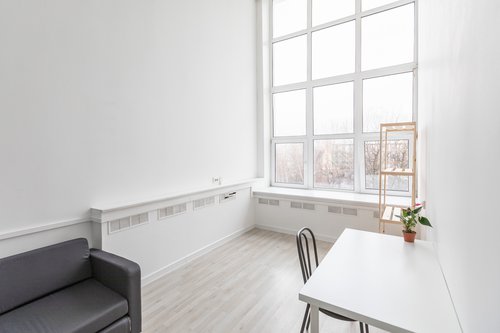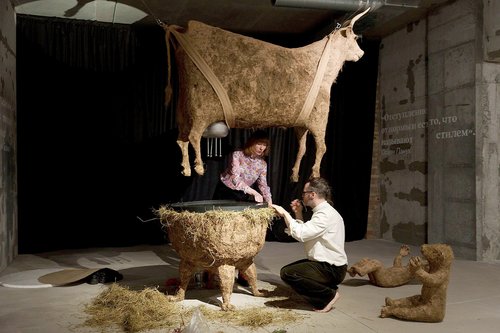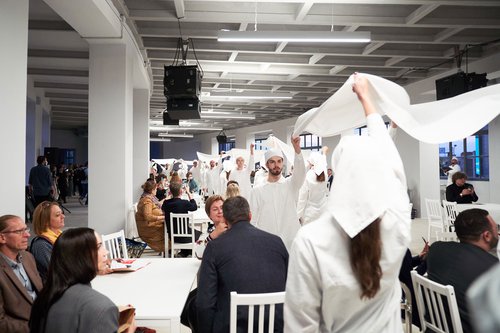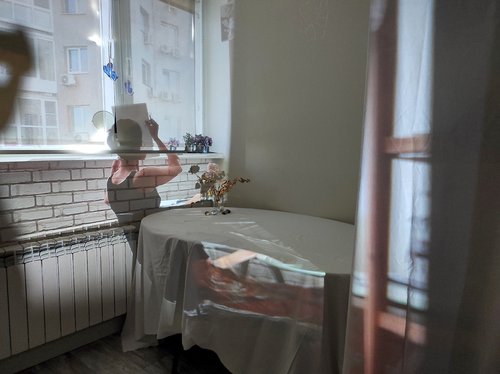Julia Abzaltdinova, Aryuna Soktueva. No. 3. Aryuna, 2023. Photo sculpture Commissioned and produced by GES-2 House of Culture. Courtesy of GES-2 House of Culture
The new outpost of the Tretyakov Gallery in Samara has launched an innovative artist-in-residence program, the first ever for a state-run art institution in Russia. Its 'Artist+' initiative connects artists with professionals from various fields and aims to foster a dialogue with audiences through educational and public activities.
Contemporary residency programs in Russia are shaped by both international influences and Soviet traditions, athough sometimes they seem to lack the most basic elements from either - like housing and artist fees. The origins of the current residency programs in Russia can be traced back to Soviet-era Houses of Artists or Houses of Writers, where creatives could live and work without the usual burdens of daily life. Typically, artists would stay there only for a few weeks and surrounded by their peers they could concentrate fully on their art in a productive atmosphere. However, any financial contribution or guaranteed opportunities for the artists to showcase their work were never on the cards.
Although this artist support program resembles Western residency programs, the current so-called ‘residency’ or ‘artist-in-residency’ programs in Russia often lack the co-living and co-creating aspects typically associated with these experiences. Today most contemporary residency programs in Russia cover travel and living expenses, materials and studio space. Usually artists do not receive any funds for their participation in the residency other than basic living expenses. This accommodation usually means separate apartments for the residents elsewhere which does not engender a shared physical space for dialogue and collaboration. As such they should be called ‘studios’ rather than ‘residencies’. However, the terms ‘residency’, ‘artist residency’ and ‘artist-in-residency’ seem to be used loosely and interchangeably by both Russian and English speakers.
The motivation for institutions to open a new artist-in-residence program or studio comes not only from the desire to support emerging artists and to build connections between cultural institutions and artists, or to attract artists to new geographical locations, but also to create content. Even though there is no expectation of a finished art project as the result of participation in an artistic residency program, participants are expected to produce some content such as conducting workshops, giving lectures, providing photos and interviews for websites and social media pages, and, in some cases, engaging in exhibition processes.
The launch of a residency program rarely is a matter for the news media, but the case of the Tretyakov Gallery branch in Samara it is more newsworthy. Unlike the best known artist support programs in Moscow, like the Vaults at GES-2, the Garage Studios, and Winzavod's Open Studios, the ‘Artist+’ program aims to connect people from various professional fields in Samara with contemporary artists, giving an opportunity not only for artists to create projects with professionals drawn across various fields, but also for locals to get involved in artistic practices which brings artists, the gallery and the public closer together.
The Vaults, Garage Studios, and Open Studios at Winzavod all share some similarities: they attract many of the same artists, most coming from Moscow and St. Petersburg, they cover artistic project production costs, and provide opportunities to participate in their own institutional public events. However, there are also differences among them.
At the Vaults, the ColLab program allows residents to use the space and equipment in four workshops: silk printing, photography, audio, and video, with studios available for six months where residents are given the necessary equipment, technical and financial support; and the Friends of the Vault program is a membership program which allows participants to use one of the workshops during the period of a month. Most of the Vaults residents seem to choose the short-term option.
Work by Julia Abzaltdinova (b. 1984) in the Vaults led to a solo exhibition “I Will Never See It. I Will Never Forget It” at GES-2 House of Culture in the Autumn of 2024. The works were created in collaboration with seven blind or visually impaired participants and focused on the fragmentary nature of visual perception. The most special memories of each participant were used by the artist as prompts to generate images using Midjourney. Later the artist created photosculptures using these generated images. The sculptures can be experienced through three channels of perception: hearing, touch, and vision. Photosculptures are meant to be touched, as well as contain images. There are also sound elements, which are activated when a viewer approaches the work. The sound is composed based on the memories of blind and low-vision co-artists, using the voice of each individual.
Ivan Gorshkov (b. 1986), an artist best known for creating total installations, came up with a ‘generator of happy accidents’ allowing him to make work using a certain material and its specific characteristics, looking at how it behaves in the process of interacting with it. This process is evocative of scientific research, where the Vaults become his laboratory. By combining different textures, volumes and material characteristics in one object, Gorshkov synthesizes his own visual language. The results of his experiments and research can be viewed at the 'Generator of Happy Accidents' exhibition, on view at GES-2 until Spring 2025.
The Garage Studios, located in a historical building at VDNKh (an acronym meaning ‘Exhibition of the Achievements of the National Economy’, a former showcase of Soviet industry, now turned into a huge park and recreational space), offers a residency program that allows artists to work in eighteen studios tucked away in a remote corner of the park. This environment helps residents escape the struggles of everyday life, as the building features a kitchen stocked with groceries provided by the museum. Some artists even choose to sleep in their studios rather than commute to their apartments. The organiser covers materials and provides access to museum resources and curatorial assistance. A unique feature of Garage Studios is its mediation program that allows visitors to engage in open dialogue with artists about their works, motivations, and interests.
Anastasia Rybakova (b. 1998), a former resident of Garage Studios, has gained recognition this year at Cosmoscow, Blazar, and catalog art fairs in Moscow. Her works on paper explore the concept of ‘face dropping’, which involves imagining or discovering the outlines of faces of different objects. Her idiosyncratic, amusing creations have captured the attention of art collectors and gallery owners. This year, Rybakova held a solo show titled ‘Kind-hearted Strawberry Grins’ at the Szena Gallery, which was curated by Anastasia Mityushina.
Current resident of Garage Studios, Alexey Buldakov (b. 1980), showcased a personal exhibition at XL Gallery in 2023, called 'Oceans of Medusa and Heracleum Militaris.' To create these sculptures, Buldakov selected bacterial cellulose as material, which he grows himself — not in jars like kombucha, but in structures resembling greenhouses. His works are rich in symbolism, conveying stories about politics and rituals rather than focusing solely on fungi and biology. Currently, the artist is working on the project ‘Farmapolis’, where he considers the fungus to be his co-artist and contemplates the relationship between host and parasite.
Winzavod Open Studios presents itself as a ‘laboratory’ where artists can co-create art. The Open Studios encourages artists to create and learn during the residency but also aims to connect artists with art collectors. Each new iteration of the residency program culminates in an exhibition, currently a show called ‘Inside the Dollhouse’. Unlike the first two programs, which primarily focus on engaging with social media and posting on their current residents, Open Studios has a dedicated section in their Instagram page to highlight the activities of former residents. Ekaterina Gerasimenko (b. 1993), who has done past residencies at both Vaults and Open Studios, recently opened a personal exhibition titled ‘Shady Backstage’ at the Martch Art Project gallery in Istanbul. Her work revolves around themes of memory and forgetting, and she employing techniques such as collage and fragmentation. The exhibition features paintings, silkscreen prints, etchings, and ceramic reliefs that incorporate images which can be filled in by our memories.
Earlier this year ‘Artist+’ at the Samara Tretyakov Gallery launched an open call for artist residency applications. The ‘+’ signifies a specialist from a non-artistic field such as a therapist, chef, microbiologist, hairdresser, entrepreneur, swimming coach, programmer, guide, or brewer who must come from Samara. These specialists will serve as mediators between the artists, the city of Samara, and the non-artistic sector. These pluses were selected prior to the opening of the call, and future participants from the artistic community are required to choose one of these pluses as their potential partner for the program. A key objective of the program is to foster connections between the arts and various professional fields.
The curator of the ‘Artist+’ program Galya Zybanova told Art Focus Now that the idea for this new type of residency emerged from the museum building itself, formerly known as The Kitchen Factory, where an initial concept was to connect chefs and artists in the creation of the ‘recipe of an artwork’. One example they looked at was the Artist Placement Group, established in 1966 in the United Kingdom, who rethought the role of the artist and their engagement with institutions. The artists were positioned in ‘non-artistic’ placements, such as in private or state organisations and afterwards, they would reflect on the newly gained experience in their artworks.
The ‘Artist+’ residency will likely include two or three public events organized by each duo. It will allow visitors to the gallery to get to know some contemporary artists and their practices as well as participate themselves in various artistic projects. Another goal is that Samara will embrace the Russian art scene as a new player and to attract new personalities to the city.
The program will run for three to four weeks for each duo, and with the help of sponsors, travel and living expenses and the cost of creating the projects will be covered, and there will even be funds given to the participants for their work. The gallery expects to host up to ten artists from December 2024 to April 2025. Those in the first wave of residents include artist Polina Uvarova (b. 1996), multimedia artist Julia Abzaltdinova, performance and graphic artist Alina Kugush (b. 1994), Yulia Shafarostova (b. 1991), sound artist Elizaveta Zgirskaya (b. 1994), multimedia artist Anastasia Zhegalina (b. 1991), feminist artist and activist Maria Rybka (b. 1992), artist and curator Filipp Krikunov (b. 1995), artist and curator Zulfia Ilkaeva (b. 1997) and Maria Michi (b. 1984). The wide variety in artistic practices and the professional fields of their companion ‘pluses’ promise an intriguing future. Watch this space.
Ivan Gorshkov. Generator of Happy Accidents
Moscow, Russia
12 December 2024 – 30 March 2025
Inside the Dollhouse
Moscow, Russia
10 December 2024 – 8 January 2025
Ekaterina Gerasimenko. Shady Backstage
Istanbul, Turkey
22 November 2024 – 11 January 2025
Artist+
Samara Branch of State Tretyakov Gallery
Samara, Russia
9 September 2024 – 30 April 2025





























